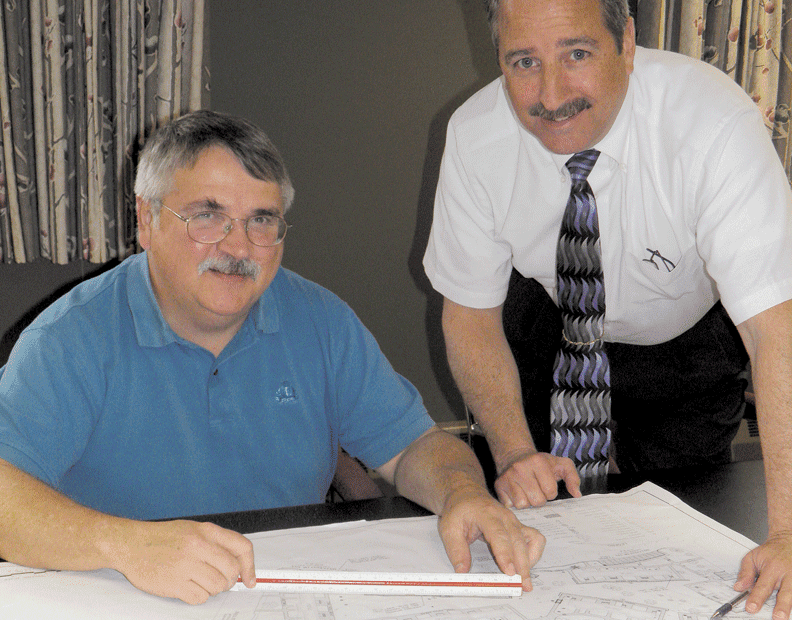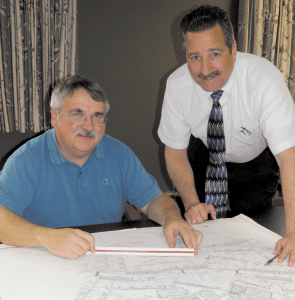
Attention to Detail
Huntley Associates Takes Pride in Its Diversity and Long History

Michael Schafer, left, and Senior Engineer Gregory Henson take pride in offering alternative designs and approaches to each of Huntley’s projects.
Specifically, he makes it a point to shake a client’s hand, look him or her in the eye, and give his word that his company will do everything possible to stay within budget and complete the project through carefully orchestrated teamwork. “It all boils down to proper planning and preliminary design. People who see the end product often don’t understand all of the steps that went into it. And in today’s economic times, proper strategic planning is important for a project to be cost-effective,” Schafer said, adding that clients are presented with alternative designs, ideas, and approaches to ensure that they are satisfied.
“When I write out a proposal, it’s very detailed. It lays out every step required from planning to finish. It also allows the client the opportunity to see the cost, which is particularly important because it can determine whether they decide to proceed,” Schafer said. For example, if a residential housing complex will intrude on wetlands, it may become cost-prohibitive or more than a client wants to spend.
“It really depends on the complexity and location, but if a project involves environmental concerns or reviews from state or federal agencies, the scope and fees can become a little fuzzy,” he continued. “For example, if a road has to cut through a swamp, there may or may not be endangered species living there, such as turtles or frogs. Wetlands are a big concern, and you have to work around them, which can mean moving the project or a building to a different location.
“A successful project can no longer be defined in purely technical terms,” he went on. “Regulatory, economic, and administrative issues are now major concerns.”
Therefore, it’s critical to lay out roadblocks to reduce the potential for change orders during construction, Schafer said.
He prides himself on creating a working relationship with everyone who will play a role in or on the job. “I promote a team approach,” Shafer said. “It involves the owner, client, and contractor as well as regulatory agencies, including towns or cities.”
They sit down together, which is important, as it allows different sectors to have input “sooner rather than later, after construction has begun,” Schafer said.
His staff members are not typical engineers. “We’re people who have been in the construction industry, so we understand the complexities involved, which makes it a positive experience for everyone. And if we help each other, the end result is typically an exceptionally constructed project that is completed within budget,” he told BusinessWest.
Schafer said unexpected issues often come to light during the building phase. “But if we work with the contractors, they work with us, so we end up with fewer change orders due to our relationship. And we like to take a project from start to finish to ensure that our clients are truly getting everything they are paying for. It helps that we know the local boards, conservation commissions, and regulations, because we have worked here for 50 years and are surveying the area in which we live.”
In the Beginning
Huntley Associates was founded by E.E. Davis in 1870, and is one of the oldest continuously practicing surveying and engineering firms in New England. “Our employees live in the area, so they are committed to making this a better place to live,” Schafer said.
The company was purchased by Almer Huntley in 1963. “At that time, the company’s main forte was surveying. The first engineering project was done in the late ’60s,” Schafer said.
The additional scope led to growth, and a second office was added in Maine. “By the late ’80s, the company had gone from a two- or three-man show to 80 employees,” he noted.
Huntley reached its peak during the ’70s and ’80s when it was called upon to do a number of projects across Western Mass. A large portion of the work was the civil and structural engineering and mechanical and electrical planning required to build wastewater-treatment plants.
“They were turnkey projects,” said Schafer, noting that the boom continued during the Reagan administration. “There was a lot of money pumped into the economy which was targeted for wastewater plants and infrastructure.”
But after Reagan left office, jobs became harder to get. There was a downturn in the economy, so Huntley closed its Maine office, and the firm stopped doing structural, mechanical, and electrical work, focusing instead on site development via civil engineering and surveying.
When Huntley made the decision to retire, Schafer purchased the firm. He had established Schafer Engineering Associates in Albany, N.Y. in 1994, and the men had worked together.
At that point, Schafer incorporated the services of his two companies. “It was done to consolidate resources and provide a larger capability to clients,” he explained, noting that today, the two companies share resources. “It allows us to keep our rates reasonable.”
Local clients who employ Huntley’s services find they can save time and money when historic records are needed, since their files date back to the mid-1800s. “We have old prints as well as plans and records from subdivisions in many communities, including Springfield and Holyoke. It’s a valuable resource,” Schafer said.
Changing Focus
In 2002, much of Huntley’s work was focused on new residential subdivisions. However, once the recession hit in 2008 and those jobs began to decline, the company’s focus changed again. Today, it’s working on subdivisions in Granby and New York as well as a nine-building apartment complex with 54 units in Amherst.
Other projects include new public-safety buildings in Granby and Montague. “And we are in the final stages of construction of a public-school expansion,” Schafer said.
His two companies have also collaborated on projects for the U.S. Department of Agriculture, and they have done work on parks in Vermont, New Hampshire, Massachusetts, and New York.
Road construction is another forte, and a recent $1.3 million project involved improving a 1.3-mile stretch along Parker Street in Springfield. “There was an overhead railroad bridge which was very narrow, so the street narrowed at that point,” Schafer said.
As a result, the crossing and bridge both had to be rebuilt, which meant the train track had to be temporarily relocated. It was a complex project and involved many agencies, as it was federally funded.
The company was also responsible for the portion of the Manhan Rail Trail that runs through Northampton. Three bridge crossings were included in the initial plan, but a reduction in budget meant it had to be changed to a street crossing. Providing access to the pathway also proved problematic due to elevated stormwater levels and telephone poles which stood in the way and could not be moved. “It took a lot of coordination and communication,” Schafer said.
But these large undertakings are only part of what the company does. “We consider ourselves a multi-disciplinary firm and have always been known as an icon in the area. But most of our work is not recognized. We do structural inspections of municipal and private buildings and a lot of assessments of historic structures,” he explained. There is also storm mitigation work, which has occurred frequently since the June tornado and major rainstorms that followed.
“A major stream bank that collapsed in Whately is threatening the water supply there, so we are helping there,” Schafer said. The company also spends time with officials in municipalities who call on them seeking advice about their treatment systems, grant applications, and landfill monitoring.
“Smaller projects are our bread and butter. We do everything from single-home surveys to surveys of 200 acres or more. And we have worked for many government agencies on the state and federal level,” Schafer said.
The company tries to be creative whenever it can, and uses environmentally sensitive approaches, such as a rain garden it designed for the Amherst apartment project that will divert the runoff of water from the buildings to the garden. “It’s an eco-friendly approach that we can use within the available budget,” he noted.
Back to Basics
The company has evolved continuously during its 142-year history, but through all that change there have been many constants.
“We’re still here and have been here for a long time,” Schafer said. “We have worked in every arena and every county, and are economical.”
But to him, what matters most is the company’s reputation.
“When I shake hands with someone or tell them something, my word is golden,” he told BusinessWest. “I get a real kick of out of helping people and enjoy solving problems. In the end, it’s not just a business. It’s what I believe in.”




